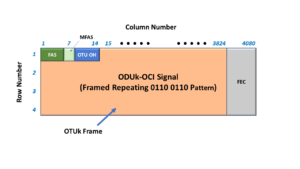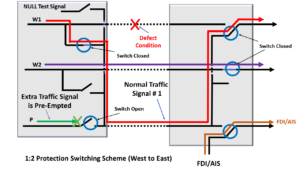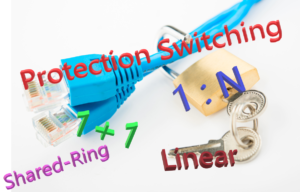What exactly is an ODUk-OCI Maintenance Signal?
OCI is an acronym for Open Connection Indicator.
OTN network equipment will often transmit the ODUk-OCI (Open Connection Indicator) Maintenance Signal to indicate that this particular OTN interface is not connected to an upstream signal (or trail termination source).
In other words, if the system configuration does not connect actual OTN traffic to an OTN interface, then the system will transmit the ODUk-OCI Maintenance signal as a replacement signal through that OTN Interface.
Whenever an OTU Network Equipment (NE) transmits an ODUk-OCI Maintenance signal, it generates and transmits a framed repeating “0110 0110” pattern within the entire ODUk signal.
More specifically, the OTN NE will generate/transmit a series of OTUk frames in which the FAS, MFAS, and OTUk Overhead fields are all valid, and the rest of the OTUk frame (e.g., the ODUk/OPUk portion of the frame) will consist of a repeating 0110 0110 pattern.
The NE will compute the FEC field based on the contents within these OTUk frames.
Figure 1 shows a simple drawing of an OTUk frame transporting the ODUk-OCI Maintenance signal.

Figure 1, Simple Illustration of an ODUk-OCI Maintenance signal within an OTUk frame
What are the timing/frequency requirements for an ODUk-OCI Maintenance signal?
The OTN NE will need to transmit this indicator at the same nominal bit rate for an ordinary OTUk signal.
Like any other OTUk signal, the OTN NE will need to transmit this data at the nominal bit-rate ±20ppm.
Table 1 presents the nominal bit-rates for the OTUk signals (and, in turn, for the OTUk signal, whenever it is transporting the ODUk-OCI Maintenance Signal) for each value of k.
Table 1, Required Bit Rates for the OTUk Signal – when transporting the ODUk-OCI Maintenance signal.

When would OTN Network Equipment transmit/generate an ODUk-OCI signal?
Earlier, I mentioned that Network Equipment would transmit the ODUk-OCI Maintenance signal via an OTN Interface signal when the system configuration has NOT connected upstream traffic to this OTN interface.
The ODUk-OCI Maintenance signal will replace OTN traffic that was intentionally disconnected from this particular OTN interface.
The ODUk-OCI Maintenance signal is similar to the ODUk-AIS and ODUk-LCK Maintenance signals. These three signals/indicators serve as replacement signals for actual OTN traffic.
However, the NE will transmit the ODUk-AIS indicator whenever the intended OTN traffic is missing due to a service-affecting defect upstream.
The NE will transmit the ODUk-LCK indicator whenever the OTN traffic is missing because the system operator has administratively locked out that particular OTN interface from all other OTN traffic.
Finally, the NE will transmit the ODUk-OCI maintenance signal whenever the OTN traffic is missing due to user configuration/provisioning (and not because of administrative lock-out).
One practical example of an OTN NE transmitting the ODUk-OCI indicator would be when an OTN traffic signal is not connecting a traffic signal to an OTN interface in an Optical Cross-Connect system.
How does a Receive Terminal detect and declare the dOCI (ODUk-OCI) defect condition?
The Receiving NE (or Sink PTE) that is downstream from the NE, which is transmitting the ODUk-OCI Maintenance signal, will detect and declare the dOCI defect condition whenever it receives a STAT field value of “1, 1, 0” within three (3) consecutive OTUk/ODUk frames.
NOTE: The STAT field is a 3-bit field that resides within the PM (Path Monitor) byte-field in the ODUk overhead.
This 3-bit field will have the value [1, 1, 0] because the NE overwrites the ODUk overhead with the repeating “0110 0110” pattern whenever it transmits the ODUk-OCI indicator.
Please see the ODUk Frame post for more information about the STAT field.
How does a Sink PTE clear the dOCI defect condition?
The Sink PTE will clear the dOCI defect condition whenever it has accepted a STAT field value of something other than “[1, 1, 0]”.
NOTE: The Sink PTE should accept a new STAT field value if it receives at least three ODUk frames that contain a consistent STAT field value.
Using the ODUk-OCI Maintenance Signal in Protection-Switching Applications
1:N and ODUk Shared-Ring Protection-Switching Systems will sometimes transport the ODUk-OCI Maintenance Signal through the Protection Transport entity (instead of the Extra-Traffic Signal) whenever we are not using the Protection Transport entity to carry the Normal Traffic Signal.
Has Inflation got You Down? Our Price Discounts Can Help You Beat Inflation and Become an Expert on OTN!! Click on the Banner Below to Learn More!!!
Discount Available for a Short Time!!
For More Information on OTN Posts in this Blog, click on the Image below.







